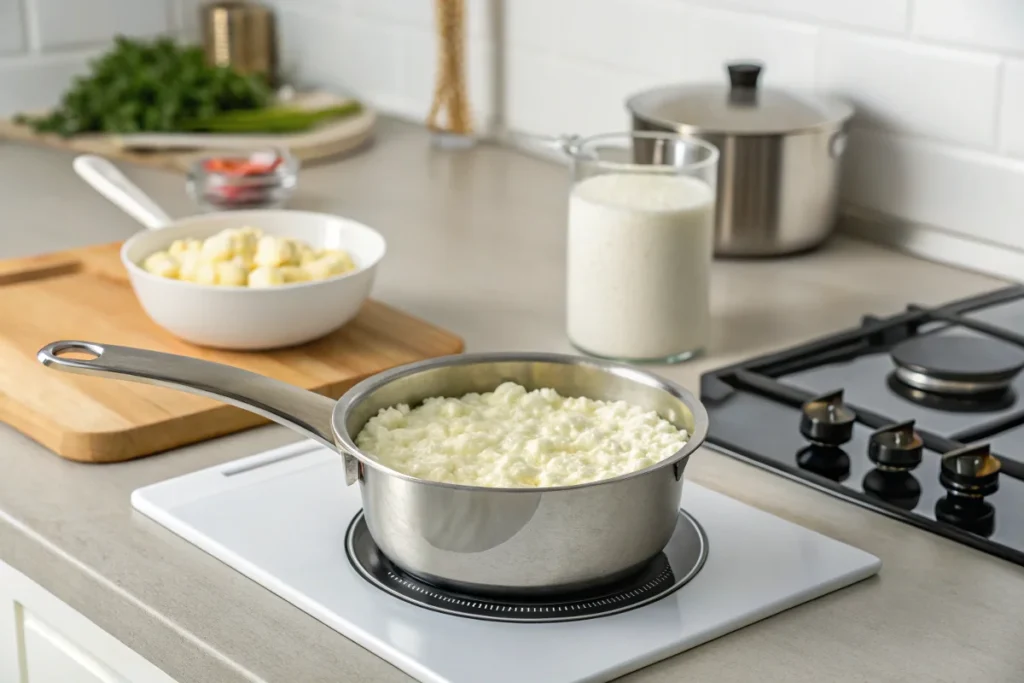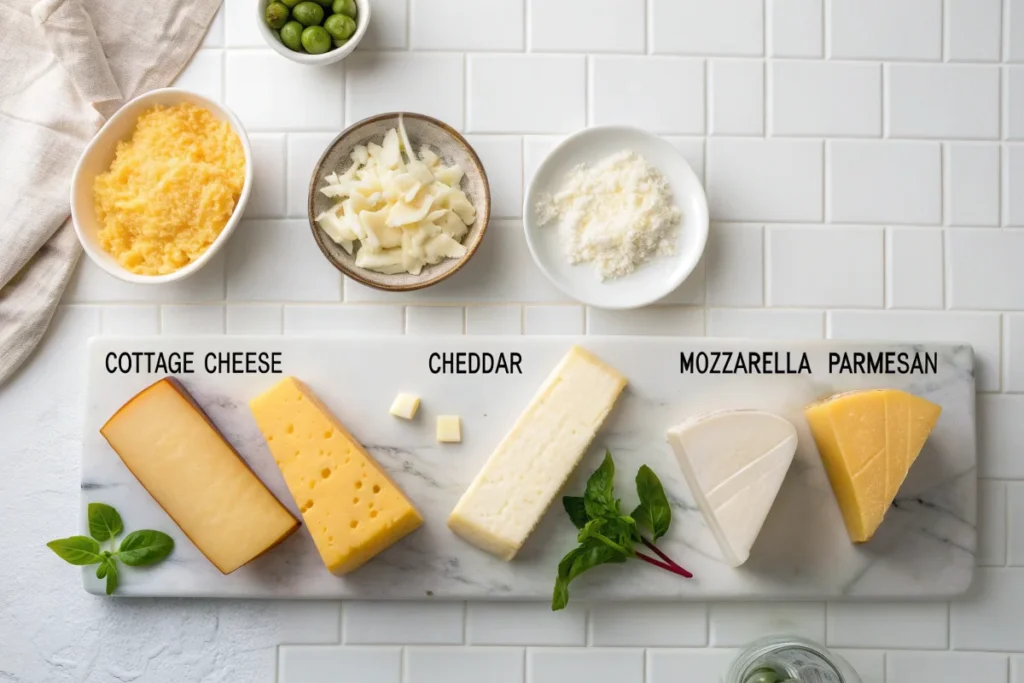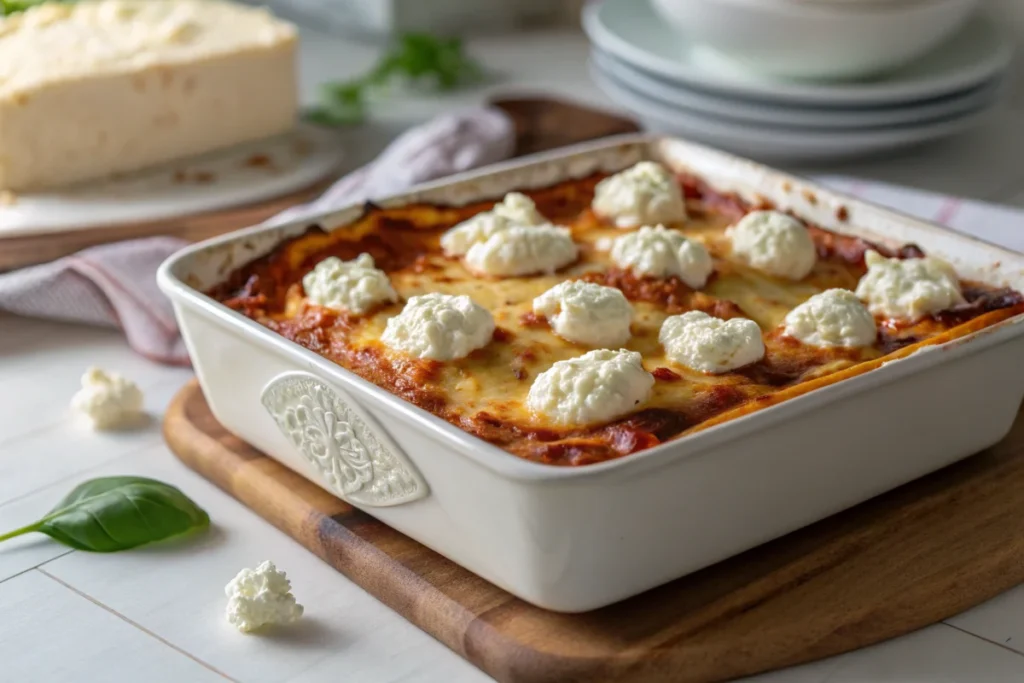Have you ever wondered if Will Cottage Cheese Melt? I love cooking at home and have tried many things. I wanted to know if cottage cheese melts.
Melting cottage cheese is tricky. It’s not like cheddar or mozzarella. It has a lot of protein and a special texture. This makes it melt differently.
Let’s learn about cottage cheese and its melting secrets. If you love cooking or just want to know more, you’ll find interesting facts. These will change how you see cottage cheese.
We’ll talk about why cottage cheese melts the way it does. We’ll also clear up myths and share tips for using it. You’ll become a pro at melting cottage cheese!
Key Ingredients: Understanding Cottage Cheese Composition
Cottage cheese is a mix of science and cooking magic. It’s not just a simple food. It’s a blend of curds, whey, and nutrients that can change your baking.
Cottage cheese starts with skimmed milk. It has little to no fat. The fat level affects how it melts. Chefs and home cooks need to know this for their recipes.
| Fat Content | Melting Characteristics | Culinary Use |
|---|---|---|
| 0% (Fat-Free) | Least creamy, more crumbly | Best for low-fat dishes |
| 2% (Low-Fat) | Moderate creaminess | Versatile in baking |
| 4-5% (Full-Fat) | Most creamy, smoother melt | Ideal for rich recipes |
The Magic of Curds and Whey
The texture of cottage cheese comes from its making process. Curds are the solid bits, and whey is the liquid. When heated, they do different things, opening up new cooking options.
Fat Content’s Impact on Melting
The fat in cottage cheese changes how it melts. More fat means a smoother melt. Full-fat cottage cheese melts like regular cheese, great for creamy dishes.
Whether making a quick breakfast or trying new cottage cheese recipes, knowing its makeup is key to success.

Step-by-Step Guide: How to Melt Cottage Cheese
Want to make your cottage cheese creamy? Melting it needs special steps. You can use different ways to make it smooth for your recipes.
Cottage cheese is special. It has a lot of water and soft proteins. So, you must heat it gently and watch it closely.
Stovetop Method for Creamy Results
Using the stovetop is the best way to melt cottage cheese. Start with a non-stick pan on low heat. Keep stirring to avoid burning and to heat evenly. Adding a bit of milk helps make it smooth.
Lightning-Fast Microwave Technique
The microwave is great for fast melting. Put cottage cheese in a safe bowl and heat in 15-second bursts. Stir after each burst to spread the heat. This is best for small amounts and you need to watch it closely. Melting Method Best For Heating Time Stovetop Controlled melting 5-7 minutes Microwave Quick small batches 30-45 seconds
Oven-Baked Method for Large Quantities
For big batches, the oven is perfect. Put cottage cheese in a dish, cover it, and bake at 350°F for 10-15 minutes. Pro tip: Add some cream to keep it moist.
Be patient with cottage cheese. Heating it slowly keeps it soft and prevents it from breaking apart.

Pro Tips for Perfect Melted Cottage Cheese
Learning to melt cottage cheese is an art. You need to know about cottage cheese temperature and consistency. Here are some pro tips to make your cheese melting better!
Achieving Smooth Consistency
For smooth melted cottage cheese, manage its texture well. Small curd cottage cheese melts better, as it has less lumps. Pro tip: mash the cottage cheese gently before heating to make it even.
Preventing Separation and Graininess
Cottage cheese has live cultures that can affect melting. To avoid graininess, use low heat. A double boiler keeps the temperature steady and stops separation.
| Melting Technique | Temperature Range | Recommended Duration |
|---|---|---|
| Stovetop (Low Heat) | Low-Medium (120-140°F) | 3-5 minutes |
| Double Boiler | Indirect Heat | 2-4 minutes |
| Microwave | 30-second intervals | 60-90 seconds total |
Enhancing Flavor While Melting
Make your melted cottage cheese taste better by adding ingredients. Taco seasoning or herbs can change its flavor. A bit of sharp cheddar can also improve taste and melting.
Be patient when melting cottage cheese. Slow heating keeps its protein and makes it creamy. This will impress all cheese lovers!

Creative Substitutions and Variations
Cottage cheese cooking lets you get creative in the kitchen. You can make it melt in your favorite dishes or try new tastes. This versatile ingredient can really change how you cook.
Cheese Sauce Magic
Want a protein-rich cheese sauce? Cottage cheese is the answer. Blend it until smooth for a creamy mix with almost 30 grams of protein per cup. Pro tip: Whip the cottage cheese until it’s silky like ricotta for the best taste.
Cheese Blend Innovations
Mix cottage cheese with other cheeses for exciting flavors. Try it with:
| Cheese Type | Flavor Profile | Best Used In |
|---|---|---|
| Parmesan | Sharp and Tangy | Pasta Dishes |
| Mozzarella | Mild and Creamy | Lasagna |
| Cheddar | Rich and Bold | Casseroles |
Dairy-Free Alternatives
For those who don’t eat dairy, there are cottage cheese-like options. You can use tofu or cashews to make a similar texture and protein. This lets everyone enjoy creative cooking.

Frequently Asked Questions About Melting Cottage Cheese
Cottage cheese can be a bit of a mystery when it comes to melting. Many home cooks wonder about its unique properties and how to use it effectively in cooking. Let’s dive into some common questions that might be simmering in your mind about melting cottage cheese.
Will Cottage Cheese Melt Like Other Cheeses?
Cottage cheese doesn’t melt like most cheeses. It has a lot of water and a special mix of proteins. This makes it hard for cottage cheese to melt smoothly.
When you heat it, cottage cheese separates instead of melting into a gooey mess.
Can You Use Melted Cottage Cheese in Recipes?
Even though cottage cheese doesn’t melt like other cheeses, it’s great in many dishes. For baking, blend it smooth first. This makes it perfect for casseroles, baked pasta, and some baked goods.
The trick is to mix it carefully so it stays creamy.
Is It Safe to Heat Cottage Cheese?
Absolutely! Heating cottage cheese is safe if you do it right. Here are some tips:
- Use low to medium heat
- Stir frequently to prevent burning
- Consume within 1-2 weeks after opening
| Cheese Type | Melting Characteristics | Best Uses |
|---|---|---|
| Cottage Cheese | Minimal melting, tends to separate | Blended dishes, baking, smoothies |
| Mozzarella | Smooth, stretchy melt | Pizza, lasagna, grilled cheese |
| Cheddar | Creamy, consistent melt | Sauces, mac and cheese |
Pro tip: For best results, blend cottage cheese before using in hot dishes to create a smoother texture.

Proper Storage of Melted Cottage Cheese
Storing heated cottage cheese is very important. It keeps the cheese good and safe to eat. The cheese’s temperature is key to keep it fresh and stop bacteria.
When the cheese cools down, put it in a tight container. Then, put it in the fridge fast. The fridge should be between 34°F and 38°F. Soft cheeses like cottage cheese can get bad fast because they are wet.
To reheat the cheese, use the microwave carefully. Start with low power and check every 10 seconds. Freezing can change the cheese’s texture. It’s best to use frozen cheese in recipes, not as a main dish.
For the cheese to last longer, keep it in the fridge’s cheese drawer. Always use clean tools when you touch it. Eat it within 3-4 days for the best taste and safety.
You May Also Like:
If you’re curious about cottage cheese and its properties, here are some related articles you might enjoy:
- Does Cottage Cheese Melt? – A deeper look into how cottage cheese behaves when heated.
- Cottage Cheese Flatbread – A unique and delicious recipe using cottage cheese as the main ingredient.

